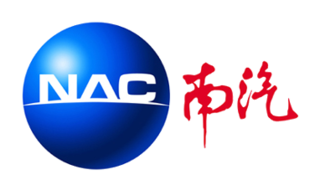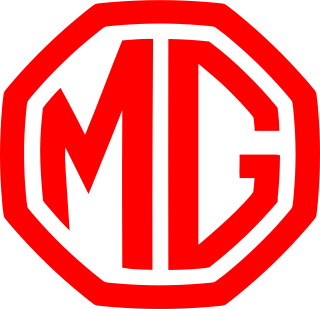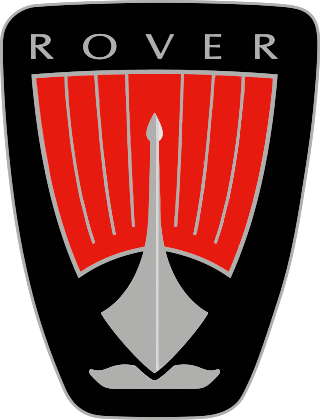Related Research Articles

Land Rover is a British brand of predominantly four-wheel drive, off-road capable vehicles, owned by multinational car manufacturer Jaguar Land Rover (JLR), since 2008 a subsidiary of India's Tata Motors. JLR currently builds Land Rovers in Brazil, China, India, Slovakia, and the United Kingdom. The Land Rover name was created in 1948 by the Rover Company for a utilitarian 4WD off-road vehicle; currently, the Land Rover range consists solely of upmarket and luxury sport utility vehicles.

Jaguar is the luxury vehicle brand of Jaguar Land Rover, a British multinational car manufacturer with its headquarters in Whitley, Coventry, England. Jaguar Cars was the company that was responsible for the production of Jaguar cars until its operations were fully merged with those of Land Rover to form Jaguar Land Rover on 1 January 2013.

MG is a British automotive marque founded by Cecil Kimber in the 1920s, and M.G. Car Company Limited was the British sports car manufacturer that made the marque famous. Best known for its open two-seater sports cars, MG also produced saloons and coupés, with engines up to three litres in size and 3.5 L in the case of the MGB GT V8. The marque is now owned by Chinese state-owned automaker SAIC Motor Corporation Limited.
The automotive industry in the United Kingdom is now best known for premium and sports car marques including Aston Martin, Bentley, Caterham Cars, Daimler, Jaguar, Lagonda, Land Rover, Lister Cars, Lotus, McLaren, Mini, MOKE, Morgan and Rolls-Royce. Volume car manufacturers with a major presence in the UK include Nissan, Toyota and Vauxhall Motors. Commercial vehicle manufacturers active in the UK include Alexander Dennis, Ford, IBC Vehicles, Leyland Trucks and London Electric Vehicle Company.

MG Rover Group was the last domestically owned mass-production car manufacturer in the British motor industry. The company was formed when BMW sold the car-making and engine manufacturing assets of the original Rover Group to the Phoenix Consortium in 2000.

British Leyland was an automotive engineering and manufacturing conglomerate formed in the United Kingdom in 1968 as British Leyland Motor Corporation Ltd (BLMC), following the merger of Leyland Motors and British Motor Holdings. It was partly nationalised in 1975, when the UK government created a holding company called British Leyland, later renamed BL in 1978. It incorporated much of the British-owned motor vehicle industry, which in 1968 had a 40 percent share of the UK car market, with its history going back to 1895. Despite containing profitable marques such as Jaguar, Rover, and Land Rover, as well as the best-selling Mini, BLMC had a troubled history, leading to its eventual collapse in 1975 and subsequent part-nationalisation.

The Rover Group plc was the British vehicle manufacturing conglomerate known as "BL plc" until 1986, which had been a state-owned company since 1975. It initially included the Austin Rover Group car business, Land Rover Group, Freight Rover vans and Leyland Trucks. The Rover Group also owned the dormant trademarks from the many companies that had merged into British Leyland and its predecessors such as Triumph, Morris, Wolseley, Riley and Alvis.

The Triumph Motor Company was a British car and motor manufacturing company in the 19th and 20th centuries. The marque had its origins in 1885 when Siegfried Bettmann of Nuremberg formed S. Bettmann & Co. and started importing bicycles from Europe and selling them under his own trade name in London. The trade name became "Triumph" the following year, and in 1887 Bettmann was joined by a partner, Moritz Schulte, also from Germany. In 1889, the businessmen started producing their own bicycles in Coventry, England.
Austin-Healey was a British sports car maker established in 1952 through a joint venture between the Austin division of the British Motor Corporation (BMC) and the Donald Healey Motor Company (Healey), a renowned automotive engineering and design firm. Leonard Lord represented BMC and Donald Healey his firm.
The Austin Rover Group was a British motor manufacturer. It was created in 1982 as the mass-market car manufacturing subsidiary of British Leyland (BL). Previously, this entity had been known as BL Cars Ltd which encompassed the Austin-Morris and Jaguar-Rover-Triumph divisions of British Leyland. After a major restructuring of BL's car manufacturing operations, Jaguar regained its independence whilst the Triumph and Morris marques were retired. The new, leaner car business was rechristened as the Austin Rover Group and focused primarily on the Austin and Rover marques. The Morris and Triumph marques continued briefly within ARG until 1984 when both were dropped.

The Rover 75 is a car which was manufactured from 1998 to 2005 and sold under the British Rover marque. It is a large family car and came in four-door saloon and five-door estate body styles. Initially built only with front-wheel drive, a rear-wheel drive variant with a V8 engine was later sold. There was also an extended-wheelbase model. In 2001, MG Rover launched a badge engineered variant, the MG ZT. A coupé concept was built, but did not receive further development.

Lea-Francis was a British motor manufacturing company that began by building bicycles.

The MG F and MG TF are mid-engined, rear wheel drive roadster cars that were sold under the MG marque by three manufacturers between 1995 and 2011.

Nanjing Automobile is a state-owned enterprise with a history that dates from 1947, making it the oldest of the Chinese automobile manufacturers although the comparatively younger FAW Automotive was the first to make cars.

The Smart Roadster (W452) was a two-door, two-seater sports car first introduced in 2002 by Smart GmbH. Sales of the Roadster and Roadster Coupé were mostly successful, and the production ended in November 2005 after 43,000 Roadsters were made. The last one built now resides in the Mercedes-Benz Museum.
Carbodies was a taxi design and manufacturing company based in Coventry, England. In its latter years it also traded as London Taxis International and The London Taxi Company.

MG Motor UK Limited is an automotive company owned by SAIC Motor UK, headquartered in London, owned by the Shanghai-based Chinese state-owned automaker SAIC Motor. MG Motor designs, develops and markets cars sold under the British MG marque, while vehicle manufacturing takes place at its plants in China, Thailand, and India. The design of the cars was originally engineered by MG Motors in the Longbridge plant in Birmingham, but now most of the design, development and R&D takes place at SAIC Motor UK Technical Centre in London.

Solihull plant is a car manufacturing factory in Lode Lane, Lode Heath, Solihull, UK, owned by Jaguar Land Rover. The plant sits on a 300-acre (120 ha) site and employs over 9,000 people in manufacturing.

Rover is a British automotive marque that was used for over a century, from 1904 to 2005. It was launched as a bicycle maker called Rover Company in 1878, before starting to manufacture autocars in 1904. The brand used the iconic Viking longship as its logo. The rights to the marque are currently part of Jaguar Land Rover, but no Rover vehicles are currently in production and the marque is considered dormant.

Abbey Panels Ltd., originally The Abbey Panel & Sheet Metal Co. Ltd., was a Warwickshire-based coachbuilding company founded on Abbey Road, Nuneaton in 1941, initially assembling Supermarine Spitfires for the ongoing war effort. The original partners were Edward Loades, Les Bean, Bill Woodhall and Ernie Wilkinson. As the business grew they expanded to Old Church Road, Coventry before having their main manufacturing plant on the well known Bayton Road Industrial Estate in Exhall. In 1967, Ted Loades listed the business on the London Stock Exchange (LSE) and it became known as Loades PLC, with Abbey Panels its main brand, alongside Albany Zinc (castings), Loades Dynamics (machining) and Loades Design . The company specialised in producing handmade prototype car bodies and did so for many notable car companies including: Bristol Cars, Lea Francis, Jaguar Cars, Rover, MG, Healey, Rolls-Royce, Buick, Lincoln, Volvo and BMW amongst others. They fashioned the bodywork of cars such as the Le Mans winning Ford GT40, numerous Jaguars, the original Mark I Land Rover Station Wagon, Jim Clark's Lotus 38 and Stirling Moss's 1957 Pescara Grand Prix winning Vanwall. They also produced many specialist parts for the aerospace industry, particularly for Rolls-Royce plc, such as the Rolls-Royce Pegasus engine duct of the Harrier jump jet.
References
- ↑ "Rover administrators 'disappointed' by bid". The Guardian . 19 July 2005.
- ↑ The Times 17 February 2006 Nanjing in talks to sell MG Rover brand to bid rival
- ↑ Coventry Evening Telegraph 22 February 2006
- ↑ Mclaren's Murray to help Kimber' AC project [ permanent dead link ]
- ↑ "AC Ace project is a Smart move". The Daily Telegraph . Archived from the original on 7 July 2016.
- ↑ AC Ace
- ↑ Autocar 7 December 2006
- ↑ Birmingham Post 12 June 2007
- ↑ Welsh Assembly press release 19 July 2006
- ↑ Auto Express 17 April 2009